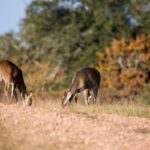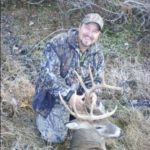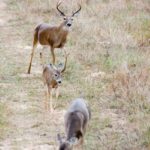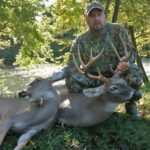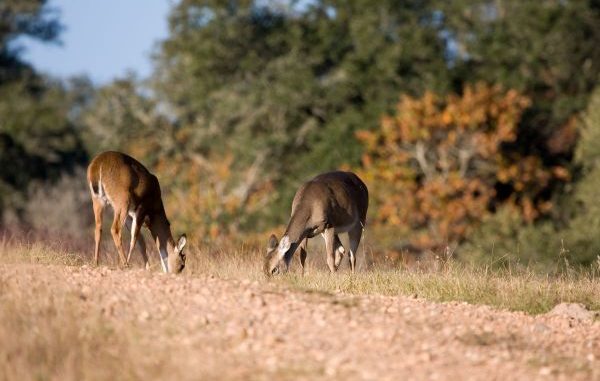
This bowhunter has figured out a system that ensures he has plenty of deer on his 80-acre hunting property. Learn how you can kill deer with a bow, even during rifle season.
Stephen Chatman would not be caught looking very long down the fork of Robert Frost’s road that bent in the undergrowth.
I’m not even sure he would save it for another day.
For Chatman, choosing to take the one less traveled has made all the difference.
If you can’t remember all the way back to junior high, Frost’s famous poem “The Road Not Taken” is about a literal and figurative road that splits into two directions.
The speaker discovers that one fork in the road is well-worn and easy to follow, whereas the other fork is grassy and wants wear.
The fork is a metaphor for choice.
Chatman made a choice 13 years ago to be a bowhunter. And, knowing how way leads on to way, he never came back to being a rifle hunter.
While speaking with Chatman at K&S Archery in Franklinton not too long ago, he said something that stopped my mind in mid-thought.
“The key to being a successful bowhunter on public land is hunting where the people aren’t,” said Chatman, who hunts a lot of public land in Missouri. “The same can be said about any land — public or private — in Louisiana.”
When pressed about how somebody could make a piece of private property a place where people weren’t, Chatman elaborated.
“People put a lot of pressure on deer during gun season,” he said. “Whether it’s people coming and going on their four-wheelers, shooting their guns or just generally wandering out on their property when they shouldn’t, deer get wise to what’s going on.
“If you make your property a place where people aren’t, the deer from surrounding properties are going to leave them and come to yours.”
In Chatman’s case, his deer sanctuary is made up of 40 acres on the side of his five acres with another 40 that belongs to his mother-in-law on the other side.
“I don’t go into this 80-and-whatever acres,” he insisted.
“At all?” I asked.
“At all,” he said.
Chatman doesn’t plant any plots, he only runs deer cameras for one week before bow season, and he spends only one day in October cutting access trails that give him easy entry and access to his two stands, no matter what the wind is doing.
“Other than that, I only go to the edges of my property once a week to put out corn,” he explained. “I have one lock-on stand on the south side of my place and one lock-on stand on the north end.”
In other words, Chatman practices self restraint in an effort to keep the deer on his property as comfortable as possible while luring skittish deer from surrounding properties that are looking for a less-harrowing place to call home.
Having property where deer aren’t as pressured as surrounding properties is especially important for deer hunters who limit themselves to hunting with bows.
“I might be able to see a deer step out into an opening at 200 yards,” Chatman said, “but, unlike a rifle hunter who can drop it right there, I’ve got to get that deer to get 170 yards closer to me.
“If that deer feels like anything is wrong, he’s not coming any closer. If I’ve got a place where he knows he’s not going to be harassed, I can get him to close the distance.”
For Chatman, getting deer to close the distance starts with strict scent control.
He maintains a ritual of washing his hunting clothes in scent-free soap, followed by drying with a scent-free dryer sheet thrown in.
Then he stores the clothing in a scent-control bag that has been sprayed down with more scent killer.
“I take every precaution,” Chatman said. “After all that, I don’t get dressed until I’m ready to leave the camp or the house. Then I spray down with that Dead Down Wind spray from head to toe — including my arrow release and my entire bow.”
But no matter what he does to try to control his scent, he still plays the wind to his advantage by always hunting the stand that is downwind.
Chatman’s second key to keeping comfortable deer on his property is to only hunt the edges.
“They’ve got food, water and cover on my place,” he said. “I just make sure the food is at the edges so I don’t have to go in the heart of my place.
“My goal is to get the deer to come to me. I figured out a few years ago, the best way to do that wasn’t to put out a pile of corn.”
To Chatman, a pile of corn looks extremely unnatural in an environment where other food sources seem so scattered out.
“Think about acorns,” he said. “They may all be under the same tree, but they’re scattered out. That’s why I started spreading corn around my stand in about a 30-yard radius. I just spray my hand with some Dead Down Wind and toss it out.”
Pulling deer to the edges of his property allows Chatman to implement the third part of his plan to draw gun-shy deer — especially big bucks — within bow range.
Rather than shoot anything that gets within range, he protects his does and shoots bucks almost exclusively during the rut.
“I’ll spend two weeks hunting bucks during October while they’re still in their bachelor groups,” Chatman said, “but after that, I don’t hunt my place until the rut kicks in about the last two weeks of December.
“In the meantime, I’ll run up to Missouri and hunt public land up there.”
And when the rut does finally kick in, Chatman uses the does as live decoys by basically allowing them free reign on his property and the protection it offers.
“That’s the absolute best way to kill a big buck that I know of,” he said. “I hunt mature bucks, and the only way I’ve been able to do that here in Louisiana is to hunt my does by waiting on the bucks to come to them.”
In Chatman’s estimation, if he has does coming to his corn he stands a good chance of seeing a buck sooner or later. In other words, he believes that if he’s got does the bucks will eventually show up.
Even after following his plan, Chatman takes it further by not shooting the first buck that shows up chasing a doe.
“Bowhunting will make you a better hunter,” he said, “because you spend so much time observing deer. When I first started bowhunting, I’d shoot the first buck that showed up. But I started letting them walk because they were generally smaller deer.
“After I started doing that, it was crazy how many times a bigger buck would come down the same trail 10 or 15 minutes later.”
Does his system work? Absolutely.
Chatman has a trophy room full of deer heads that prove it. But there’s some more proof he’s noticed that makes him feel he’s on to something.
“Even though they’re on my property where they aren’t nearly as pressured, I’ve seen how the does react to a rifle shot coming from a neighbor’s property,” he said. “They’ll pick their heads up and take notice, but rather than run off, they’ll put their heads back down and go back to feeding.”
And when they do that, Chatman realizes that all the effort he puts into making his property a place where people aren’t has paid off.
Comfortable does in bow range that have bucks on their minds will eventually turn into comfortable bucks in bow range that have does on their minds.
Making the conscious choice to hunt only with a bow, especially during the middle of rifle season, might not be the path most hunters take, but for Chatman it has been one of the best decisions he has ever made.
The road less traveled can certainly be a more-challenging path, but the rewards revealed along the way will make all the difference when it comes to deer hunting with a bow during rifle season.
Black Eagle arrows gaining ground
I’ve got to admit that I’m a neophyte when it comes to bowhunting. Therefore, one arrow is just as good as another to me.
However, while listening to Stephen Chatman talk about arrows, I began to wonder if there were as many variables in choosing an arrow as there is in picking fishing line.
 Some extensive testing at his archery shop in Franklinton has him standing firmly behind a relative newcomer on scene — Black Eagle arrows.
Some extensive testing at his archery shop in Franklinton has him standing firmly behind a relative newcomer on scene — Black Eagle arrows.
“I started testing them two years ago,” Chatman said. “Last year, I started shooting ASA with them. They’re starting to show up in lots of quivers, and in my opinion they’re primed to take over the arrow world.”
Chatman’s affinity for Black Eagle arrows stems from them being the straightest arrow he’s ever shot. He builds his own arrows, and he’s used to cutting some of both ends to get his as straight as possible.
“With these,” he said, “I have yet to have had to cut off both sides. I can cut off one side, and it’s good to go. The tolerance is so much better, too. I can cut four other arrows that are 8.2 grains per inch and have four arrows that range from 1 to 3 grains difference.
“With Black Eagle, I cut four and they’re going to be within a half grain of each other.”
Chatman has also tested their penetration at his bow range, and he was impressed.
“It’s because of their carbon weave,” he explained. “When an arrow hits its target, there’s some flexing that takes place, which takes away from its penetration.
“These arrows have less flex at impact, which means more energy is passed on into penetration.”
And to top it off, Chatman can sell a dozen of the highest-end Black Eagle arrows for $114 per dozen, whereas other brands can run upwards of $180 per dozen.
“I don’t think I can go wrong with them. That’s why I shoot them,” he said. “They weigh probably 10 grains less than other brands, but they penetrate 7 to 8 inches farther.”
For more information about Black Eagle arrows, contact Chatman at K&S Archery at 985-839-7709 or www.blackeaglearrows.com.
